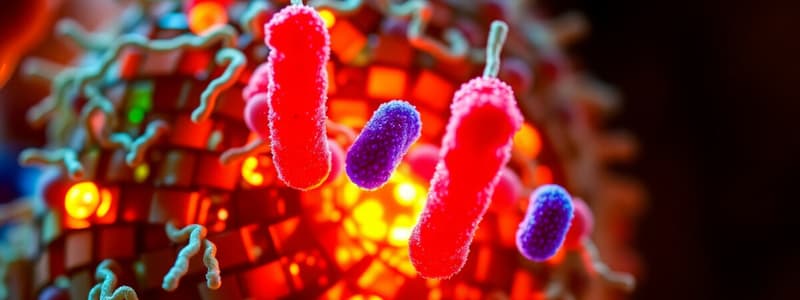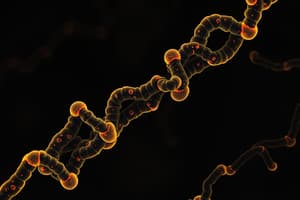Podcast
Questions and Answers
What is a karyotype primarily used for?
What is a karyotype primarily used for?
- Studying protein synthesis
- Identifying the function of individual genes
- Analyzing the number and structure of chromosomes (correct)
- Determining a cell's metabolic rate
Which structure is crucial for the proper segregation of chromosomes during cell division?
Which structure is crucial for the proper segregation of chromosomes during cell division?
- Telomere
- Nucleosome
- Histone
- Kinetochore (correct)
What is the primary role of telomerase in chromosome maintenance?
What is the primary role of telomerase in chromosome maintenance?
- Facilitating DNA replication
- Elongating telomeres (correct)
- Repairing chromosomal breaks
- Condensing chromatin
Which of the following best describes heterochromatin?
Which of the following best describes heterochromatin?
What characterizes a chromosome territory within a cell?
What characterizes a chromosome territory within a cell?
Which of the following is NOT a consequence of changes in telomere length?
Which of the following is NOT a consequence of changes in telomere length?
In karyotype analysis, what does the term 'banding pattern' refer to?
In karyotype analysis, what does the term 'banding pattern' refer to?
Which region of the chromosome is involved in the assembly of the spindle fibers during cell division?
Which region of the chromosome is involved in the assembly of the spindle fibers during cell division?
Which structural change of homologous chromosomes is listed alphabetically via abbreviation?
Which structural change of homologous chromosomes is listed alphabetically via abbreviation?
What does the abbreviation 'hsr' indicate in cytogenetics?
What does the abbreviation 'hsr' indicate in cytogenetics?
In which circumstance would the receptor chromosome be listed before the donor chromosome?
In which circumstance would the receptor chromosome be listed before the donor chromosome?
What is indicated by a semicolon in the listing of aberrations?
What is indicated by a semicolon in the listing of aberrations?
Why is the notation involving square brackets important in karyotyping?
Why is the notation involving square brackets important in karyotyping?
What is the main reason for the evolution of nomenclature in cytogenetics?
What is the main reason for the evolution of nomenclature in cytogenetics?
What does the abbreviation 'dic' refer to in cytogenetic nomenclature?
What does the abbreviation 'dic' refer to in cytogenetic nomenclature?
What is the purpose of using a detailed system for chromosome band descriptions?
What is the purpose of using a detailed system for chromosome band descriptions?
What does a break suspected at the interface of two bands require in terms of numbering?
What does a break suspected at the interface of two bands require in terms of numbering?
Which of the following best characterizes the use of oncology microarrays in genetics?
Which of the following best characterizes the use of oncology microarrays in genetics?
What is the primary function of Nucleolar Organizer Regions (NORs)?
What is the primary function of Nucleolar Organizer Regions (NORs)?
How are chromosomes classified based on their centromere position?
How are chromosomes classified based on their centromere position?
What does the term 'banding resolution' refer to in chromosome analysis?
What does the term 'banding resolution' refer to in chromosome analysis?
What staining technique is primarily used to visualize centromeric regions of chromosomes?
What staining technique is primarily used to visualize centromeric regions of chromosomes?
Which statement about G-banding is correct?
Which statement about G-banding is correct?
In karyotyping, what is the correct order of reporting?
In karyotyping, what is the correct order of reporting?
What does the nomenclature '7q34' represent?
What does the nomenclature '7q34' represent?
Which of the following is NOT a staining technique used in chromosome analysis?
Which of the following is NOT a staining technique used in chromosome analysis?
What does DAPI staining primarily identify?
What does DAPI staining primarily identify?
Why must final reports include the level of banding resolution?
Why must final reports include the level of banding resolution?
Which chromosomes are identified as acrocentric?
Which chromosomes are identified as acrocentric?
What is primarily analyzed in oncology microarrays?
What is primarily analyzed in oncology microarrays?
Which type of chromosome has its centromere located in the middle?
Which type of chromosome has its centromere located in the middle?
Flashcards are hidden until you start studying
Study Notes
General/Background
- Chromatin: DNA and associated proteins in the nucleus, forms chromosomes.
- Chromosome: A highly organized structure of DNA and proteins that contains genetic material.
- Chromatid: One of the two identical copies of a chromosome, joined at the centromere.
- Chromosome Territories: Regions within the nucleus where chromosomes occupy specific positions.
- Histone: A protein that associates with DNA to form nucleosomes.
- Nucleosome: The basic unit of chromatin structure, consisting of DNA wrapped around a core of eight histone proteins.
- Centromere: A constricted region of the chromosome where spindle fibers attach during cell division.
- Kinetochore: A protein complex assembled at the centromere, which connects to microtubules during cell division.
- Neocentromere: A newly formed centromere at a different location on a chromosome.
- Telomere: Repetitive DNA sequences at the ends of chromosomes, protecting them from degradation.
- Karyogram: A visual representation of chromosomes arranged in order by size and shape.
- Karyotype: The characteristic chromosome complement of an individual or species.
- Autosome: Any chromosome that is not a sex chromosome (X or Y).
- Repetitive DNA: DNA sequences that are repeated many times in the genome.
- Pseudoautosomal Regions: Regions on the X and Y chromosomes that share homologous sequences.
- Banding/Banding Pattern: Distinctive patterns of light and dark bands on chromosomes, revealed by staining techniques.
- Euchromatin: Less condensed, gene-rich regions of chromosomes.
- Heterochromatin: Highly condensed, gene-poor regions of chromosomes.
- Locus (loci): The specific location of a gene on a chromosome.
- Allele: An alternative form of a gene.
Chromosome Structures and Function
- Types of DNA sequences: Different DNA sequences influence chromosome structure; repetitive DNA and gene-rich regions play a specific role.
- Chromosome structure and histone variants: Histone variants contribute to the formation of different chromosome structures.
- Chromosome Condensation:
- Components: Histones, topoisomerases, and other proteins are involved in chromosome condensation.
- Consequences of protein change: Alterations in protein availability or modifications impact condensation levels.
- Centromere:
- Function: Attaches to spindle fibers during cell division, ensuring proper chromosome segregation.
- Location: Constricted region of the chromosome.
- Gene Content: Centromere contains unique repetitive DNA sequences and a few genes involved in centromere function.
- Importance: Essential for proper chromosome segregation and cell division.
- Kinetochore:
- Function: Attaches to microtubules, mediating chromosome movement during mitosis and meiosis.
- Location: Attached to the centromere.
- Kinetochore, chromosome condensation, and centromere positioning:
- A tightly regulated process, involving kinase activity and the Anaphase Promoting Complex (APC).
- Telomere:
- Function: Protect chromosome ends from degradation and fusion, and regulate cell lifespan.
- Length: Telomeres shorten with each cell division; telomerase enzyme adds nucleotides to the ends to prevent depletion.
- Telomerase activity: Can be regulated by various factors, influencing cell ageing and proliferation.
- Consequences of telomere change: Changes in telomere length affect cellular processes such as cell division, aging, and cancer development.
- Telomere Associated Proteins:
- They protect telomeres and regulate telomerase activity.
Studying That Suits You
Use AI to generate personalized quizzes and flashcards to suit your learning preferences.




